DutyHub
UX/UI Research & Design

Overview
Roles: UX/UI Researcher & Designer
Duration: October 2023 - April 2024
Tools: Figma, InVision
In today's ever-evolving military environment, clear communication, efficient mission planning, and accessible training resources are critical to the success and safety of our active-duty soldiers. DutyHub aims to transform soldiers' communication, mission planning, and training access through innovative technology, ultimately boosting their preparedness and performance in the field.
Project Details
Design Goal
The design goal of DutyHub is to develop a user-centric application that revolutionizes military operations by simplifying processes, enhancing information dissemination, and providing soldiers with the necessary tools for success.
Target Users
DutyHub targets individuals aged 18 and above, encompassing soldiers at various stages of their military careers, from recruits to seasoned veterans. It is exclusively designed for those affiliated with the U.S. Army branch, ensuring that its features meet the unique requirements of Army personnel. Participants from diverse backgrounds, experiences, ranks, and roles within the Army are encouraged to provide their perspectives, ensuring a comprehensive understanding of users' needs.
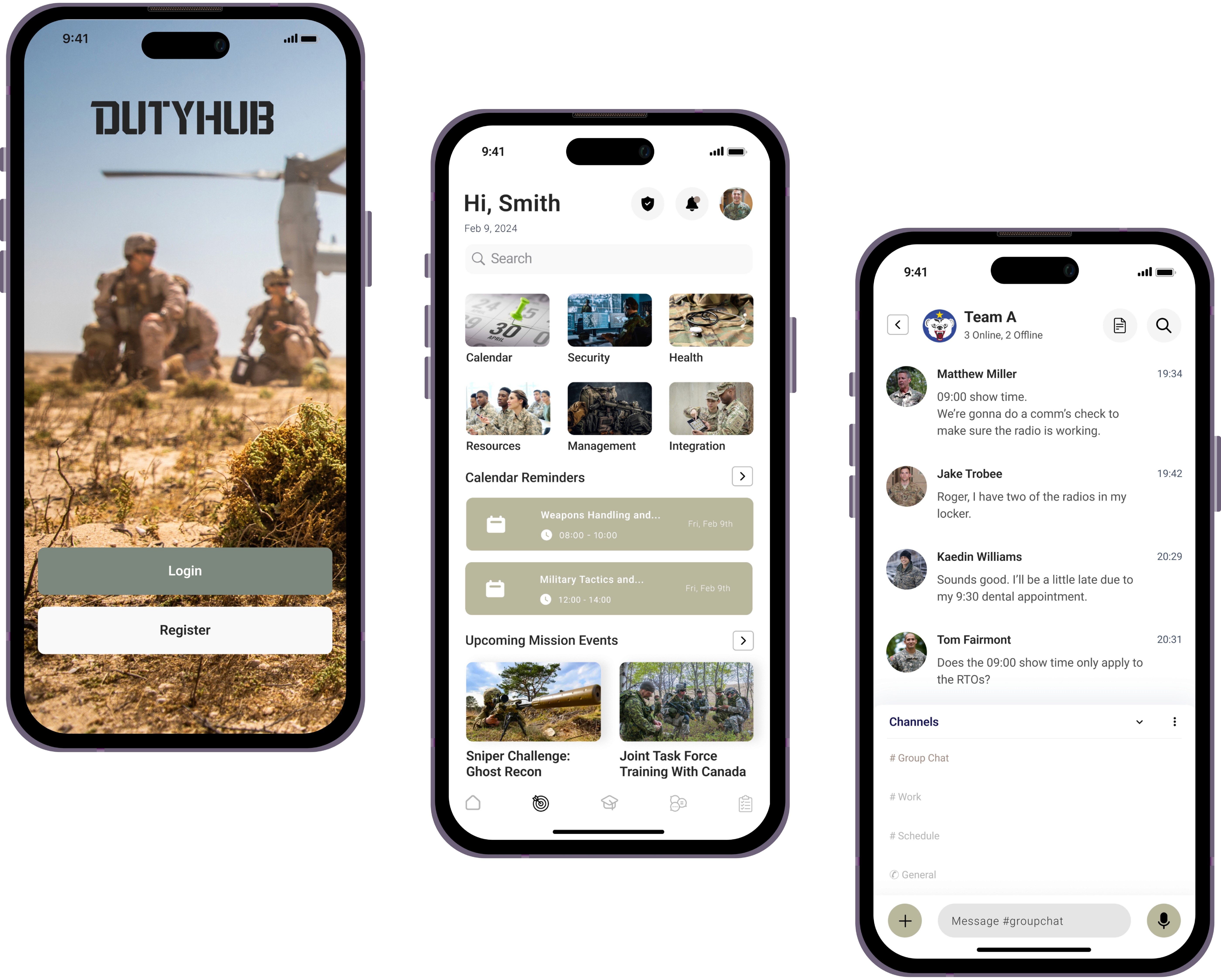
Research
In the early phases of the DutyHub project, I began user research and analysis directly within the Army community. This involved actively engaging with active-duty soldiers to gain firsthand insights into their experiences, needs, and challenges.
I also explored the American army website to understand more about the apps, websites, and tools commonly utilized by military personnel, such as Postmates and IPPS-A, Army Training Network, Army Career Tracker (ACT), and Army Learning Management System (ALMS). This ensured that my research not only drew from established sources but also integrated practical insights gained from examining the tools and platforms currently utilized within the Army branch.
Survey
The DutyHub survey comprises 26 questions covering various aspects of military life, communication, training, equipment management, and security. Participants were encouraged to share their experiences, challenges, and feature preferences to guide app development.
Additional Research
I extended the survey outreach to include veterans within the U.S. Army, providing a broader perspective on military experiences. Veterans offer unique insights into communication, mission planning, training, and equipment management, enriching DutyHub's understanding of military operations.
Their feedback aids in identifying areas for improvement and informing features tailored to support the transition from active duty to civilian life. By incorporating perspectives from both active-duty soldiers and veterans, DutyHub ensures a comprehensive approach to addressing the needs of the military community, resulting in a more impactful application.
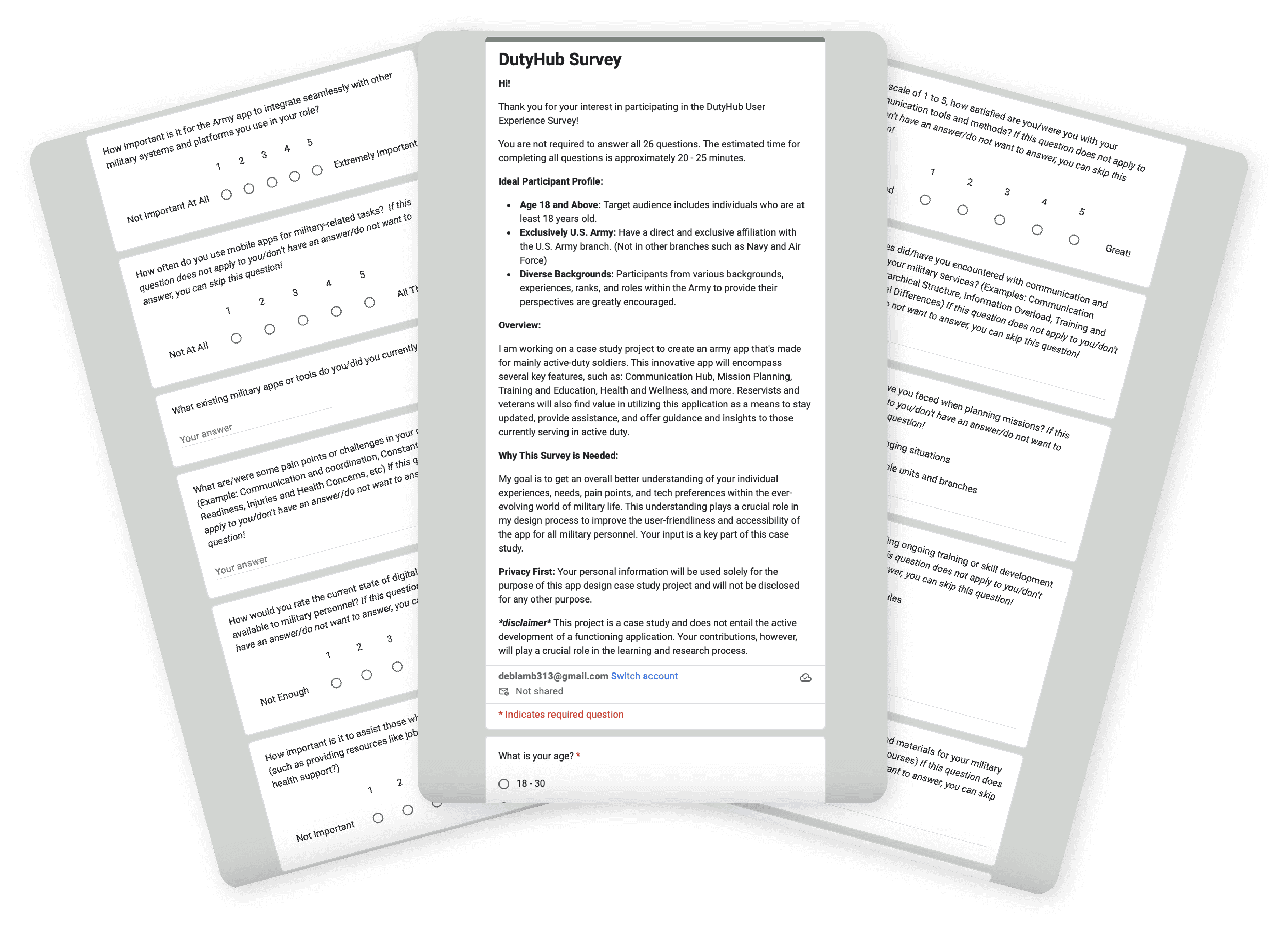
Insights
• Hierarchical structures and intricate systems hinder effective communication.
• Challenges in coordinating with multiple units and branches.
• Need for dynamic mission planning tools to facilitate real-time collaboration.
• Desire for regularly updated modules and access to interactive learning materials.
• Desire for features like maintenance reminders and appointment tracking.
• Need for improved equipment management tools to enhance accountability.
• Essential security measures include end-to-end encryption and user authentication.
• Priority on robust security protocols to safeguard sensitive information.
Opportunities
• Develop a streamlined communication hub accessible to soldiers of all ranks.
• Introduce real-time collaboration features for improved information exchange.
• Implement tools facilitating coordination across units and adaptability in changing situations.
• Centralize training resources and offer diverse interactive learning materials.
• Introduce features for equipment tracking, maintenance scheduling, and supply request forms.
• Prioritize robust security measures such as end-to-end encryption and user authentication.
• Provide resources for soldiers transitioning to civilian life, including job search assistance and mental health support.
Affinity Mapping
I structured and visualized research findings, categorizing insights into key areas including communication, mission planning, training, equipment management, and security.

Personas
Drawing from research findings, two personas were crafted to embody typical active-duty soldiers, each reflecting unique roles, preferences, and requirements within the military environment.
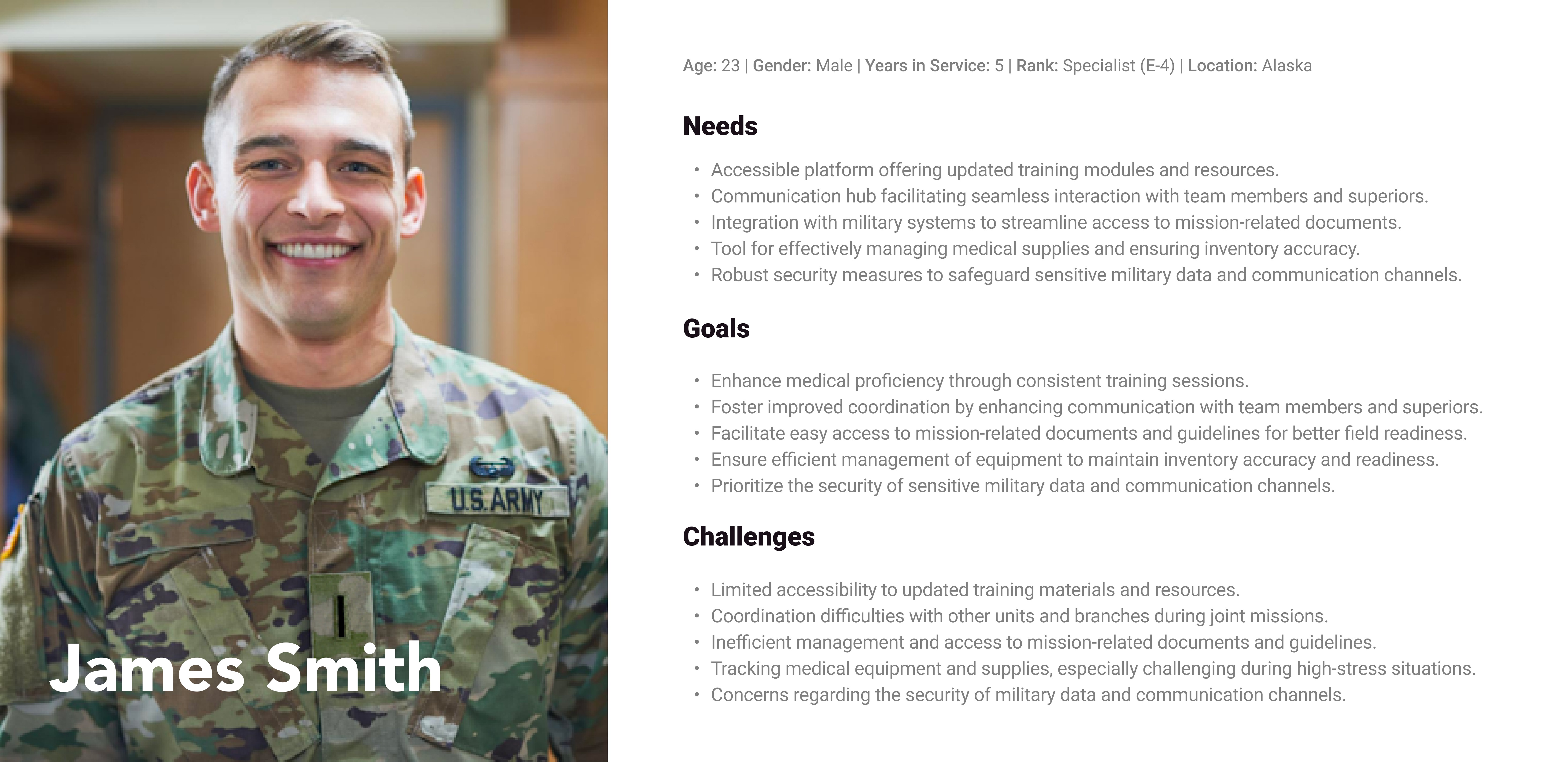
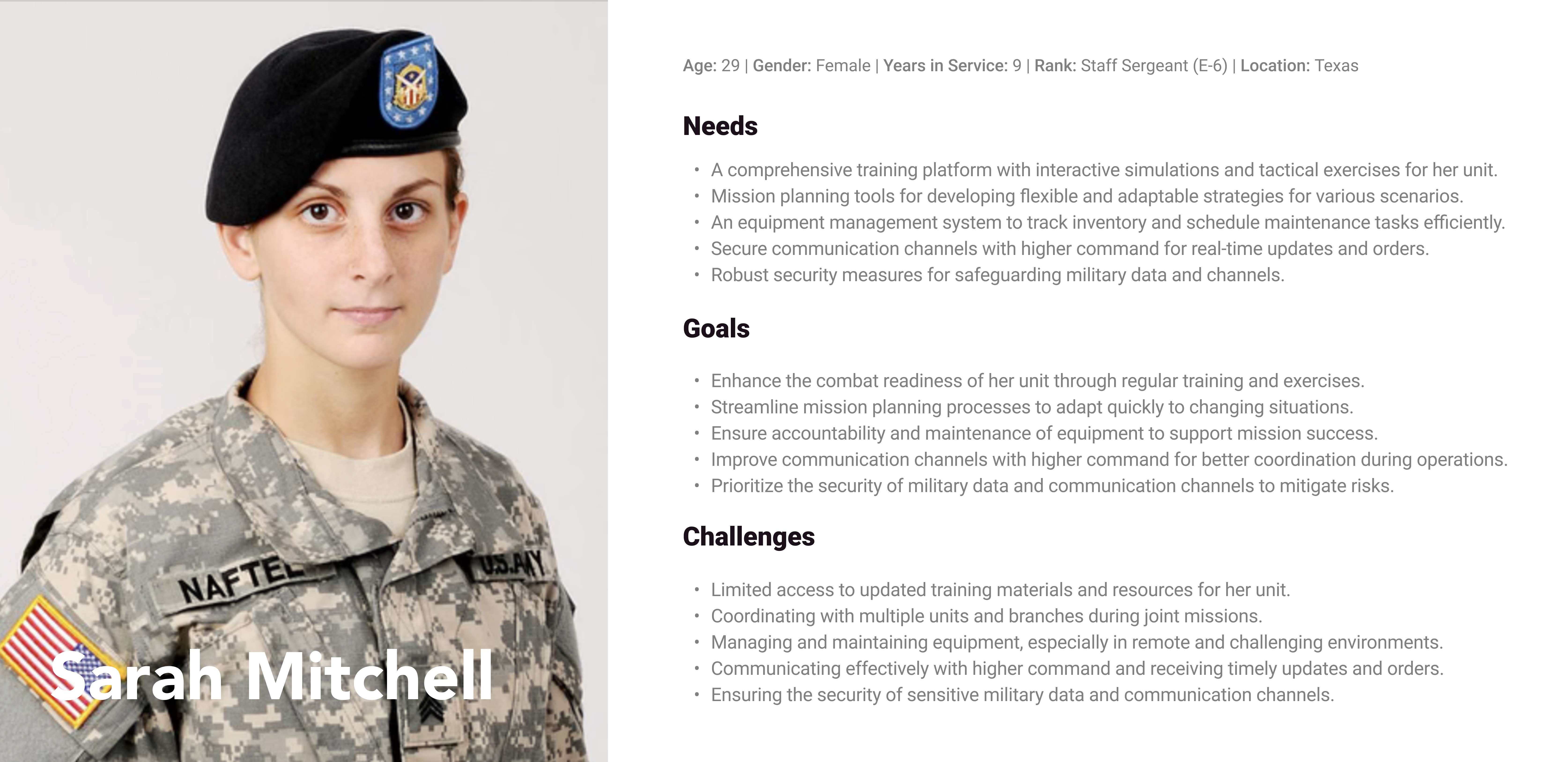
User Flow Map
A detailed user flow map was crafted to illustrate the soldier's navigation through DutyHub, starting from accessing communication utilities to engaging in training activities and overseeing equipment management.

Wireframing
I began brainstorming sessions to generate innovative ideas for DutyHub's features and functionalities. These concepts were swiftly sketched out to capture the essence of each idea before being meticulously translated into wireframes.
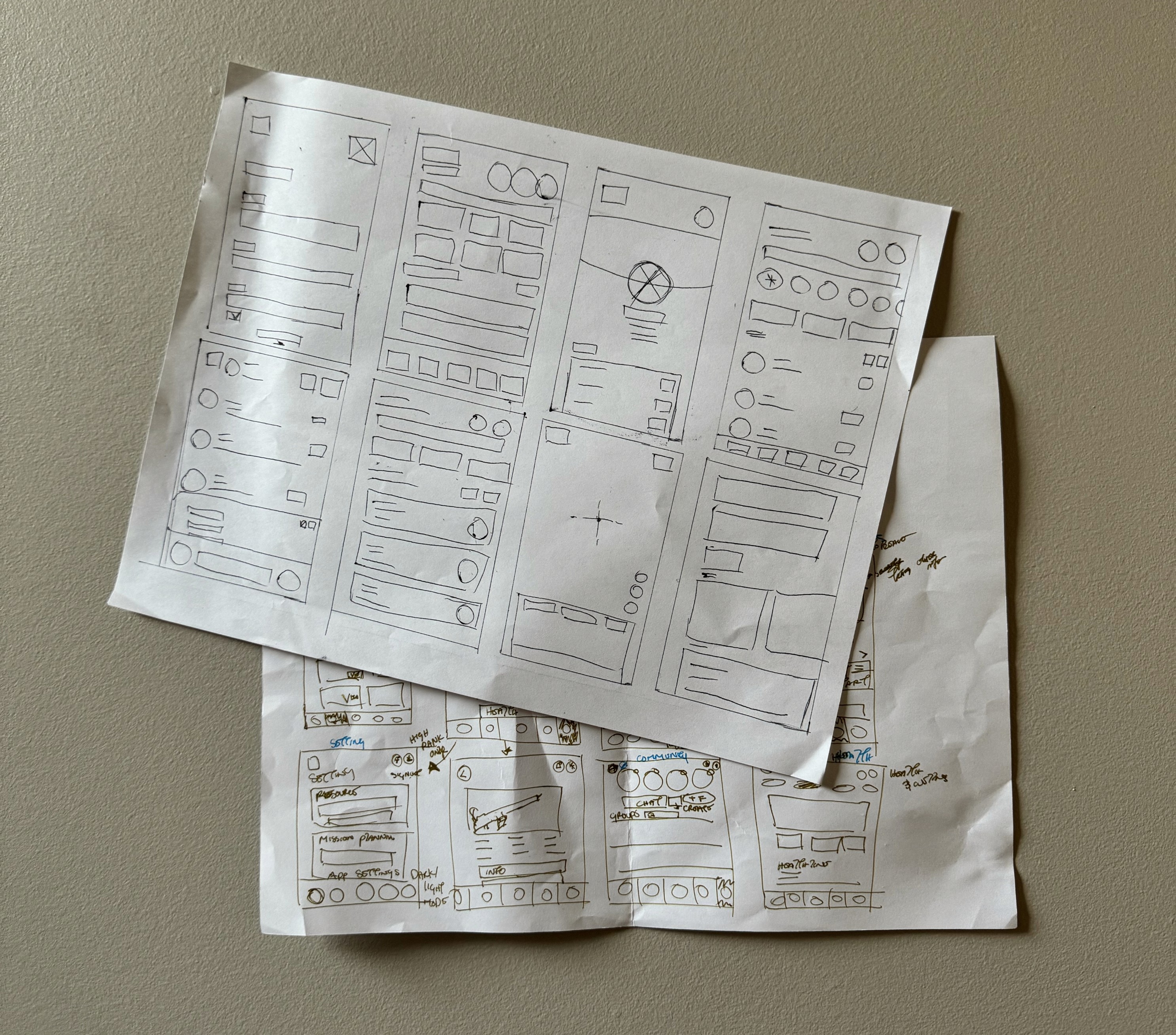
Design Systems
To ensure the components are implemented consistently across the app, I created a UI guide with details on colour palettes, typography, and reusable UI elements.

Visual Design
DutyHub is thoughtfully designed to prioritize usability, efficiency, and accessibility for military personnel. With a clean and intuitive interface, users can easily navigate through the app's features, ensuring seamless interaction and task completion.
The design elements are tailored to reflect the unique needs of soldiers, incorporating familiar military terminology and visual cues to enhance familiarity and comfort while using the application.
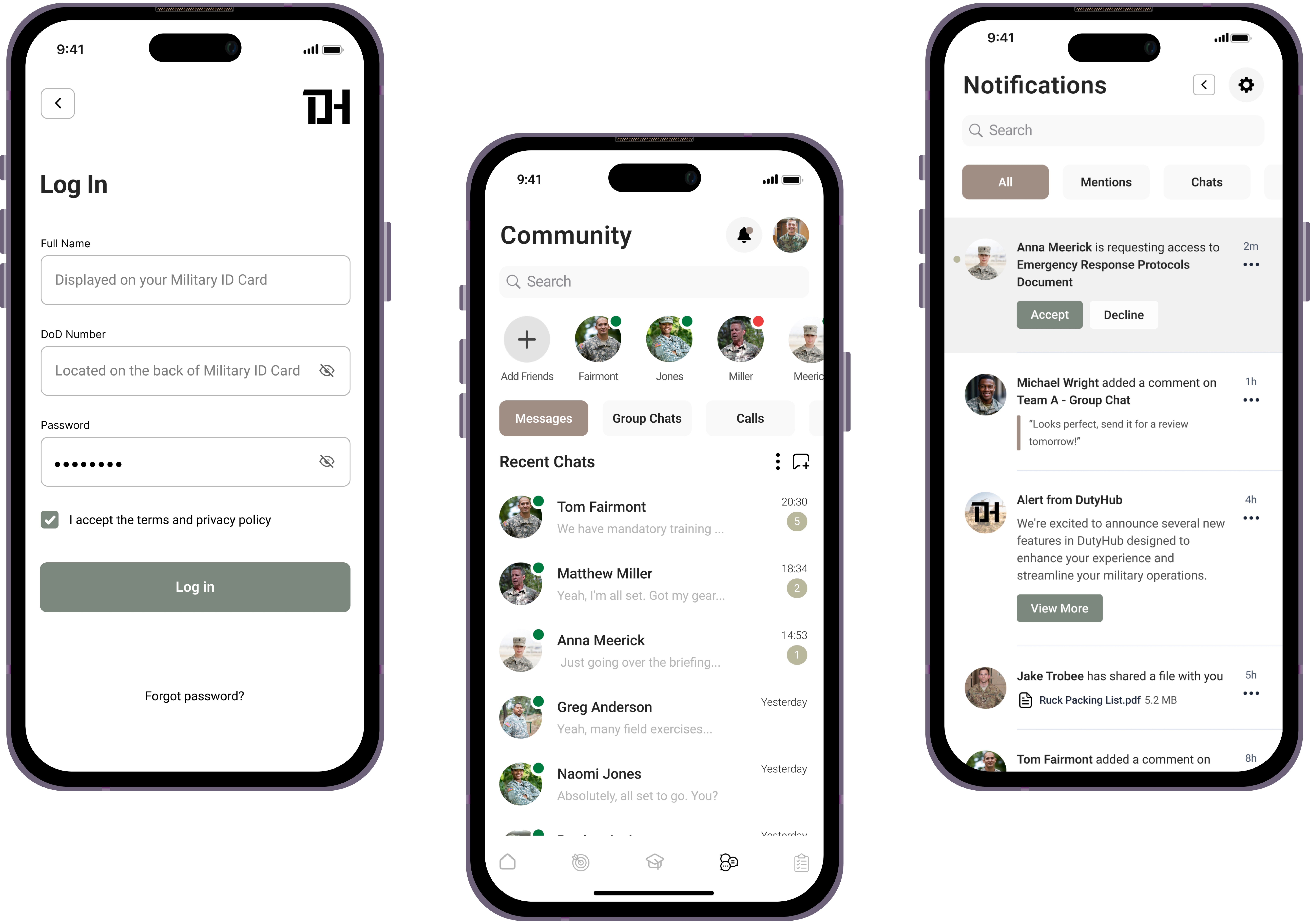
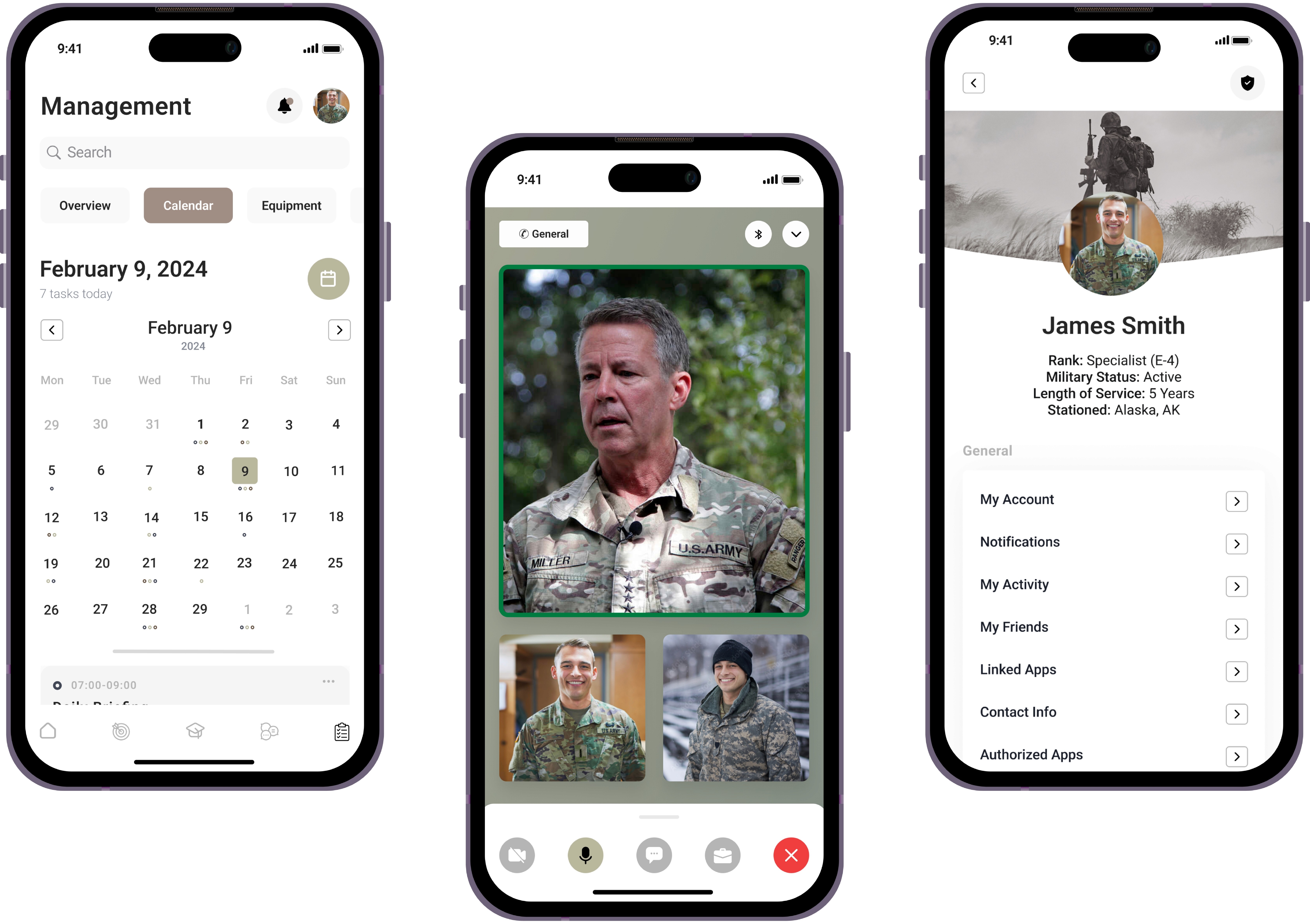

Takeaways
Throughout the development of DutyHub, I have encountered numerous insights and challenges that have contributed to my growth as a UX/UI researcher and designer. The project provided invaluable insights into the complexities of military operations and the unique needs of soldiers, emphasizing the importance of empathy-driven design and thorough user research.
Next Steps
I plan to continuously iterate and improve DutyHub to ensure it meets the evolving needs of military personnel and remains effective in enhancing mission readiness and operational efficiency. I am excited to continue refining the platform based on user feedback and emerging technologies, ensuring that DutyHub remains a valuable tool for enhancing mission readiness and supporting the well-being of soldiers.
DutyHub
UX/UI Research & Design

Overview
Roles: UX/UI Researcher & Designer
Duration: October 2023 - April 2024
Tools: Figma, InVision
In today's ever-evolving military environment, clear communication, efficient mission planning, and accessible training resources are critical to the success and safety of our active-duty soldiers. DutyHub aims to transform soldiers' communication, mission planning, and training access through innovative technology, ultimately boosting their preparedness and performance in the field.
Project Details
Design Goal
The design goal of DutyHub is to develop a user-centric application that revolutionizes military operations by simplifying processes, enhancing information dissemination, and providing soldiers with the necessary tools for success.
Target Users
DutyHub targets individuals aged 18 and above, encompassing soldiers at various stages of their military careers, from recruits to seasoned veterans. It is exclusively designed for those affiliated with the U.S. Army branch, ensuring that its features meet the unique requirements of Army personnel. Participants from diverse backgrounds, experiences, ranks, and roles within the Army are encouraged to provide their perspectives, ensuring a comprehensive understanding of users' needs.

Research
In the early phases of the DutyHub project, I began user research and analysis directly within the Army community. This involved actively engaging with active-duty soldiers to gain firsthand insights into their experiences, needs, and challenges.
I also explored the American army website to understand more about the apps, websites, and tools commonly utilized by military personnel, such as Postmates and IPPS-A, Army Training Network, Army Career Tracker (ACT), and Army Learning Management System (ALMS). This ensured that my research not only drew from established sources but also integrated practical insights gained from examining the tools and platforms currently utilized within the Army branch.
Survey
The DutyHub survey comprises 26 questions covering various aspects of military life, communication, training, equipment management, and security. Participants were encouraged to share their experiences, challenges, and feature preferences to guide app development.
Additional Research
I extended the survey outreach to include veterans within the U.S. Army, providing a broader perspective on military experiences. Veterans offer unique insights into communication, mission planning, training, and equipment management, enriching DutyHub's understanding of military operations.
Their feedback aids in identifying areas for improvement and informing features tailored to support the transition from active duty to civilian life. By incorporating perspectives from both active-duty soldiers and veterans, DutyHub ensures a comprehensive approach to addressing the needs of the military community, resulting in a more impactful application.

Insights
• Hierarchical structures and intricate systems hinder effective communication.
• Challenges in coordinating with multiple units and branches.
• Need for dynamic mission planning tools to facilitate real-time collaboration.
• Desire for regularly updated modules and access to interactive learning materials.
• Desire for features like maintenance reminders and appointment tracking.
• Need for improved equipment management tools to enhance accountability.
• Essential security measures include end-to-end encryption and user authentication.
• Priority on robust security protocols to safeguard sensitive information.
Opportunities
• Develop a streamlined communication hub accessible to soldiers of all ranks.
• Introduce real-time collaboration features for improved information exchange.
• Implement tools facilitating coordination across units and adaptability in changing situations.
• Centralize training resources and offer diverse interactive learning materials.
• Introduce features for equipment tracking, maintenance scheduling, and supply request forms.
• Prioritize robust security measures such as end-to-end encryption and user authentication.
• Provide resources for soldiers transitioning to civilian life, including job search assistance and mental health support.
Affinity Mapping
I structured and visualized research findings, categorizing insights into key areas including communication, mission planning, training, equipment management, and security.

Personas
Drawing from research findings, two personas were crafted to embody typical active-duty soldiers, each reflecting unique roles, preferences, and requirements within the military environment.


User Flow Map
A detailed user flow map was crafted to illustrate the soldier's navigation through DutyHub, starting from accessing communication utilities to engaging in training activities and overseeing equipment management.

Wireframing
I began brainstorming sessions to generate innovative ideas for DutyHub's features and functionalities. These concepts were swiftly sketched out to capture the essence of each idea before being meticulously translated into wireframes.

Design Systems
To ensure the components are implemented consistently across the app, I created a UI guide with details on colour palettes, typography, and reusable UI elements.

Visual Design
DutyHub is thoughtfully designed to prioritize usability, efficiency, and accessibility for military personnel. With a clean and intuitive interface, users can easily navigate through the app's features, ensuring seamless interaction and task completion.
The design elements are tailored to reflect the unique needs of soldiers, incorporating familiar military terminology and visual cues to enhance familiarity and comfort while using the application.



Takeaways
Throughout the development of DutyHub, I have encountered numerous insights and challenges that have contributed to my growth as a UX/UI researcher and designer. The project provided invaluable insights into the complexities of military operations and the unique needs of soldiers, emphasizing the importance of empathy-driven design and thorough user research.
Next Steps
I plan to continuously iterate and improve DutyHub to ensure it meets the evolving needs of military personnel and remains effective in enhancing mission readiness and operational efficiency. I am excited to continue refining the platform based on user feedback and emerging technologies, ensuring that DutyHub remains a valuable tool for enhancing mission readiness and supporting the well-being of soldiers.
DutyHub
UX/UI Research & Design

Overview
Roles: UX/UI Researcher & Designer
Duration: October 2023 - April 2024
Tools: Figma, InVision
In today's ever-evolving military environment, clear communication, efficient mission planning, and accessible training resources are critical to the success and safety of our active-duty soldiers. DutyHub aims to transform soldiers' communication, mission planning, and training access through innovative technology, ultimately boosting their preparedness and performance in the field.
Project Details
Design Goal
The design goal of DutyHub is to develop a user-centric application that revolutionizes military operations by simplifying processes, enhancing information dissemination, and providing soldiers with the necessary tools for success.
Target Users
DutyHub targets individuals aged 18 and above, encompassing soldiers at various stages of their military careers, from recruits to seasoned veterans. It is exclusively designed for those affiliated with the U.S. Army branch, ensuring that its features meet the unique requirements of Army personnel. Participants from diverse backgrounds, experiences, ranks, and roles within the Army are encouraged to provide their perspectives, ensuring a comprehensive understanding of users' needs.

Research
In the early phases of the DutyHub project, I began user research and analysis directly within the Army community. This involved actively engaging with active-duty soldiers to gain firsthand insights into their experiences, needs, and challenges.
I also explored the American army website to understand more about the apps, websites, and tools commonly utilized by military personnel, such as Postmates and IPPS-A, Army Training Network, Army Career Tracker (ACT), and Army Learning Management System (ALMS). This ensured that my research not only drew from established sources but also integrated practical insights gained from examining the tools and platforms currently utilized within the Army branch.
Survey
The DutyHub survey comprises 26 questions covering various aspects of military life, communication, training, equipment management, and security. Participants were encouraged to share their experiences, challenges, and feature preferences to guide app development.
Additional Research
I extended the survey outreach to include veterans within the U.S. Army, providing a broader perspective on military experiences. Veterans offer unique insights into communication, mission planning, training, and equipment management, enriching DutyHub's understanding of military operations.
Their feedback aids in identifying areas for improvement and informing features tailored to support the transition from active duty to civilian life. By incorporating perspectives from both active-duty soldiers and veterans, DutyHub ensures a comprehensive approach to addressing the needs of the military community, resulting in a more impactful application.

Insights
• Hierarchical structures and intricate systems hinder effective communication.
• Challenges in coordinating with multiple units and branches.
• Need for dynamic mission planning tools to facilitate real-time collaboration.
• Desire for regularly updated modules and access to interactive learning materials.
• Desire for features like maintenance reminders and appointment tracking.
• Need for improved equipment management tools to enhance accountability.
• Essential security measures include end-to-end encryption and user authentication.
• Priority on robust security protocols to safeguard sensitive information.
Opportunities
• Develop a streamlined communication hub accessible to soldiers of all ranks.
• Introduce real-time collaboration features for improved information exchange.
• Implement tools facilitating coordination across units and adaptability in changing situations.
• Centralize training resources and offer diverse interactive learning materials.
• Introduce features for equipment tracking, maintenance scheduling, and supply request forms.
• Prioritize robust security measures such as end-to-end encryption and user authentication.
• Provide resources for soldiers transitioning to civilian life, including job search assistance and mental health support.
Affinity Mapping
I structured and visualized research findings, categorizing insights into key areas including communication, mission planning, training, equipment management, and security.

Personas
Drawing from research findings, two personas were crafted to embody typical active-duty soldiers, each reflecting unique roles, preferences, and requirements within the military environment.


User Flow Map
A detailed user flow map was crafted to illustrate the soldier's navigation through DutyHub, starting from accessing communication utilities to engaging in training activities and overseeing equipment management.

Wireframing
I began brainstorming sessions to generate innovative ideas for DutyHub's features and functionalities. These concepts were swiftly sketched out to capture the essence of each idea before being meticulously translated into wireframes.

Design Systems
To ensure the components are implemented consistently across the app, I created a UI guide with details on colour palettes, typography, and reusable UI elements.

Visual Design
DutyHub is thoughtfully designed to prioritize usability, efficiency, and accessibility for military personnel. With a clean and intuitive interface, users can easily navigate through the app's features, ensuring seamless interaction and task completion.
The design elements are tailored to reflect the unique needs of soldiers, incorporating familiar military terminology and visual cues to enhance familiarity and comfort while using the application.



Takeaways
Throughout the development of DutyHub, I have encountered numerous insights and challenges that have contributed to my growth as a UX/UI researcher and designer. The project provided invaluable insights into the complexities of military operations and the unique needs of soldiers, emphasizing the importance of empathy-driven design and thorough user research.
Next Steps
I plan to continuously iterate and improve DutyHub to ensure it meets the evolving needs of military personnel and remains effective in enhancing mission readiness and operational efficiency. I am excited to continue refining the platform based on user feedback and emerging technologies, ensuring that DutyHub remains a valuable tool for enhancing mission readiness and supporting the well-being of soldiers.
DutyHub
UX/UI Research & Design

Overview
Roles: UX/UI Researcher & Designer
Duration: October 2023 - April 2024
Tools: Figma, InVision
In today's ever-evolving military environment, clear communication, efficient mission planning, and accessible training resources are critical to the success and safety of our active-duty soldiers. DutyHub aims to transform soldiers' communication, mission planning, and training access through innovative technology, ultimately boosting their preparedness and performance in the field.
Project Details
Design Goal
The design goal of DutyHub is to develop a user-centric application that revolutionizes military operations by simplifying processes, enhancing information dissemination, and providing soldiers with the necessary tools for success.
Target Users
DutyHub targets individuals aged 18 and above, encompassing soldiers at various stages of their military careers, from recruits to seasoned veterans. It is exclusively designed for those affiliated with the U.S. Army branch, ensuring that its features meet the unique requirements of Army personnel. Participants from diverse backgrounds, experiences, ranks, and roles within the Army are encouraged to provide their perspectives, ensuring a comprehensive understanding of users' needs.

Research
In the early phases of the DutyHub project, I began user research and analysis directly within the Army community. This involved actively engaging with active-duty soldiers to gain firsthand insights into their experiences, needs, and challenges.
I also explored the American army website to understand more about the apps, websites, and tools commonly utilized by military personnel, such as Postmates and IPPS-A, Army Training Network, Army Career Tracker (ACT), and Army Learning Management System (ALMS). This ensured that my research not only drew from established sources but also integrated practical insights gained from examining the tools and platforms currently utilized within the Army branch.
Survey
The DutyHub survey comprises 26 questions covering various aspects of military life, communication, training, equipment management, and security. Participants were encouraged to share their experiences, challenges, and feature preferences to guide app development.
Additional Research
I extended the survey outreach to include veterans within the U.S. Army, providing a broader perspective on military experiences. Veterans offer unique insights into communication, mission planning, training, and equipment management, enriching DutyHub's understanding of military operations.
Their feedback aids in identifying areas for improvement and informing features tailored to support the transition from active duty to civilian life. By incorporating perspectives from both active-duty soldiers and veterans, DutyHub ensures a comprehensive approach to addressing the needs of the military community, resulting in a more impactful application.

Insights
• Hierarchical structures and intricate systems hinder effective communication.
• Challenges in coordinating with multiple units and branches.
• Need for dynamic mission planning tools to facilitate real-time collaboration.
• Desire for regularly updated modules and access to interactive learning materials.
• Desire for features like maintenance reminders and appointment tracking.
• Need for improved equipment management tools to enhance accountability.
• Essential security measures include end-to-end encryption and user authentication.
• Priority on robust security protocols to safeguard sensitive information.
Opportunities
• Develop a streamlined communication hub accessible to soldiers of all ranks.
• Introduce real-time collaboration features for improved information exchange.
• Implement tools facilitating coordination across units and adaptability in changing situations.
• Centralize training resources and offer diverse interactive learning materials.
• Introduce features for equipment tracking, maintenance scheduling, and supply request forms.
• Prioritize robust security measures such as end-to-end encryption and user authentication.
• Provide resources for soldiers transitioning to civilian life, including job search assistance and mental health support.
Affinity Mapping
I structured and visualized research findings, categorizing insights into key areas including communication, mission planning, training, equipment management, and security.

Personas
Drawing from research findings, two personas were crafted to embody typical active-duty soldiers, each reflecting unique roles, preferences, and requirements within the military environment.


User Flow Map
A detailed user flow map was crafted to illustrate the soldier's navigation through DutyHub, starting from accessing communication utilities to engaging in training activities and overseeing equipment management.

Wireframing
I began brainstorming sessions to generate innovative ideas for DutyHub's features and functionalities. These concepts were swiftly sketched out to capture the essence of each idea before being meticulously translated into wireframes.

Design Systems
To ensure the components are implemented consistently across the app, I created a UI guide with details on colour palettes, typography, and reusable UI elements.

Visual Design
DutyHub is thoughtfully designed to prioritize usability, efficiency, and accessibility for military personnel. With a clean and intuitive interface, users can easily navigate through the app's features, ensuring seamless interaction and task completion.
The design elements are tailored to reflect the unique needs of soldiers, incorporating familiar military terminology and visual cues to enhance familiarity and comfort while using the application.



Takeaways
Throughout the development of DutyHub, I have encountered numerous insights and challenges that have contributed to my growth as a UX/UI researcher and designer. The project provided invaluable insights into the complexities of military operations and the unique needs of soldiers, emphasizing the importance of empathy-driven design and thorough user research.
Next Steps
I plan to continuously iterate and improve DutyHub to ensure it meets the evolving needs of military personnel and remains effective in enhancing mission readiness and operational efficiency. I am excited to continue refining the platform based on user feedback and emerging technologies, ensuring that DutyHub remains a valuable tool for enhancing mission readiness and supporting the well-being of soldiers.

